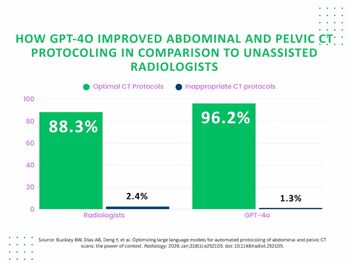
Thoughtful CT Scanning Can Sharply Cut Radiation Doses to Breast, Lungs
Careful consideration of CT scanning protocols can cut breast radiation burden by 50 percent, according to a new study in the American Journal of Roentgenology.
Careful consideration of CT scanning protocols can cut breast radiation burden by 50 percent, according to
The study compared organ doses to the breast, lungs and pelvis using commonly used protocols with an anthropomorphic phantom. Researchers used 64-MDCT with metal oxide semiconductor field effect transistor (MOSFET) detectors in the breast (skin and parenchyma), the lungs, and the upper and lower pelvis.
Researchers found that the highest doses to the breast skin and parenchyma were found with standard thoracic CT protocols (120 kVp, variable 120-320 mA) and the protocol used to assess for pulmonary embolism in the general population (120kVp, variable 200-394 mA), said Diana Litmanovich, MD, of Harvard Medical School in Boston and the study’s lead author. The team found the dose was reduced by more than half when they used a protocol for assessing pulmonary embolism in pregnant or young patients (100 kVP, fixed 200 mA).
The standard thoracic CT and the pulmonary embolism protocols also led to the highest radiation doses to the lung, Litmanovich said. The lung received the highest organ dose regardless of the protocol, while pelvic radiation was low regardless of the protocol, she said.
“Despite efforts to reduce radiation dose, irradiation of the breast and lung remain substantial,” said Litmanovich. “The study emphasizes the need for caution when we are planning our CT protocols.”
Newsletter
Stay at the forefront of radiology with the Diagnostic Imaging newsletter, delivering the latest news, clinical insights, and imaging advancements for today’s radiologists.




























